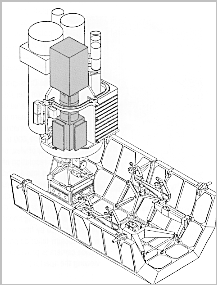|
|||||||||||||||||||
|
|
|||||||||||||||||||
|
|
Instrument Description
- Developing Institution: University of Wisconsin
- Telescope Optics: Cassegrain system, f/10 focal ratio
- Instrument: Spectropolarimeter with dual electronic diode array detectors
- Primary Mirror: 50 centimeters (20 inches) diameter
- Field of View: 3.3 x 4.4 arc-minutes
- Spectral Resolution: 6 angstroms
- Wavelength Range: 1,400 to 3,200 angstroms
- Magnitude Limit: 16
- Weight: 446 kilograms (981 pounds)
- Diameter: 70 centimeters (28 inches)
- Length: 3.7 meters (12.14 feet) length
WUPPE was designed to obtain simultaneous spectra and polarization measurements from 1400 to 3300Å. WUPPE has a 0.5m f/10 classical Cassegrain telescope (area = 1,800 square centimeters, 279 square inches) and a spectropolarimeter, with a field of view of 3.3 by 4.4 arc-minutes and a resolution of 6 angstroms. The telescope feeds light to a low resolution spectrometer equipped with various polarimetric analyzers. The spectrometer is a modified Monk-Gilleson spectrometer: two rotating wheels are used to select the focal plane aperture and the polarimetric analyzer; a magnesium fluoride Wollaston polarizing beam-splitter placed between the aperture and the relay mirror splits the beam into two orthogonally-polarized spectra which fall on the detector. The detector consists of dual Reticon self-scanning linear arrays of 1024 pixel photodiodes (to detect both beams simultaneously) coupled by fiber optics to a microchannel plate intensifier with a cesium-telluride photocathode. A charge-coupled device camera is provided for target acquisition and for viewing the aperture during a measurement. The focal plane scale is 26 arcsec/mm and the dispersion is 78 Å/mm, blaze at 2000 Angstroms. A set of halfwave plates at 6 different angles provided spectropolarimetric modulation with 5 angstrom resolution on point sources through apertures from 6 to 40 arcsec. A "Lyot" analyzer was used to provide 50-100 angstrom spectropolarimetric resolution on faint point targets and diffuse nebulae.

Page taken from WUPPE Web site
|
|
|




 Follow Us
Follow Us